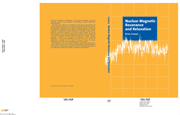Book contents
- Frontmatter
- Contents
- Preface
- 1 Introduction
- 2 Theoretical background
- 3 Detection methods
- 4 Classical view of relaxation
- 5 Quantum treatment of relaxation
- 6 Dipolar lineshape in solids
- 7 Relaxation in liquids
- 8 Some case studies
- 9 The density operator and applications
- 10 NMR imaging
- Appendix A Fourier analysis
- Appendix B Random functions
- Appendix C Interaction picture
- Appendix D Magnetic fields and canonical momentum
- Appendix E Alternative classical treatment of relaxation
- Appendix F Gm(t) for rotationally invariant systems
- Appendix G P(Ω, Ωo, t) for rotational diffusion
- Problems
- References
- Index
3 - Detection methods
Published online by Cambridge University Press: 02 December 2009
- Frontmatter
- Contents
- Preface
- 1 Introduction
- 2 Theoretical background
- 3 Detection methods
- 4 Classical view of relaxation
- 5 Quantum treatment of relaxation
- 6 Dipolar lineshape in solids
- 7 Relaxation in liquids
- 8 Some case studies
- 9 The density operator and applications
- 10 NMR imaging
- Appendix A Fourier analysis
- Appendix B Random functions
- Appendix C Interaction picture
- Appendix D Magnetic fields and canonical momentum
- Appendix E Alternative classical treatment of relaxation
- Appendix F Gm(t) for rotationally invariant systems
- Appendix G P(Ω, Ωo, t) for rotational diffusion
- Problems
- References
- Index
Summary
The CW method
Frequency and time domains
We have seen in Chapter 1 that the essential features of a resonance phenomenon may be investigated by looking at the system's response to a small sinusoidal disturbance of varying frequency. This is called the continuous wave (CW) method and is the technique traditionally used in most branches of spectroscopy. Alternatively, as we also saw in Chapter 1, we may look at the time response to a transient excitation, this being called the pulse method in NMR.
Results of the two methods have been shown to be equivalent, one response being the Fourier transform of the other. However, if we look at the history of the subject we find that studying the frequency response (CW) was the method used almost exclusively for the first ten years of NMR, i.e. 1946–56. In Andrew's book (Andrew, 1955) for instance 27 pages are devoted to CW experimental methods while pulse methods are treated in a page and a half. Erwin Hahn is usually thought of as the father of pulsed NMR due to his important paper in 1950. Other important contributors include Carr and Purcell (1954) and Torrey (1952).
Since Andrew's book was written, pulsed NMR has to a large extent eclipsed CW NMR. There are two main reasons for this. Firstly, it is much easier to measure the relaxation times T1 and T2 using pulse methods. In fact the long T2 values found in some liquids can only be measured by the pulse technique because magnet inhomogeneity masks the weaker effects of spin–spin coupling. This point will be taken up again in the following chapter.
- Type
- Chapter
- Information
- Nuclear Magnetic Resonance and Relaxation , pp. 46 - 82Publisher: Cambridge University PressPrint publication year: 1997

